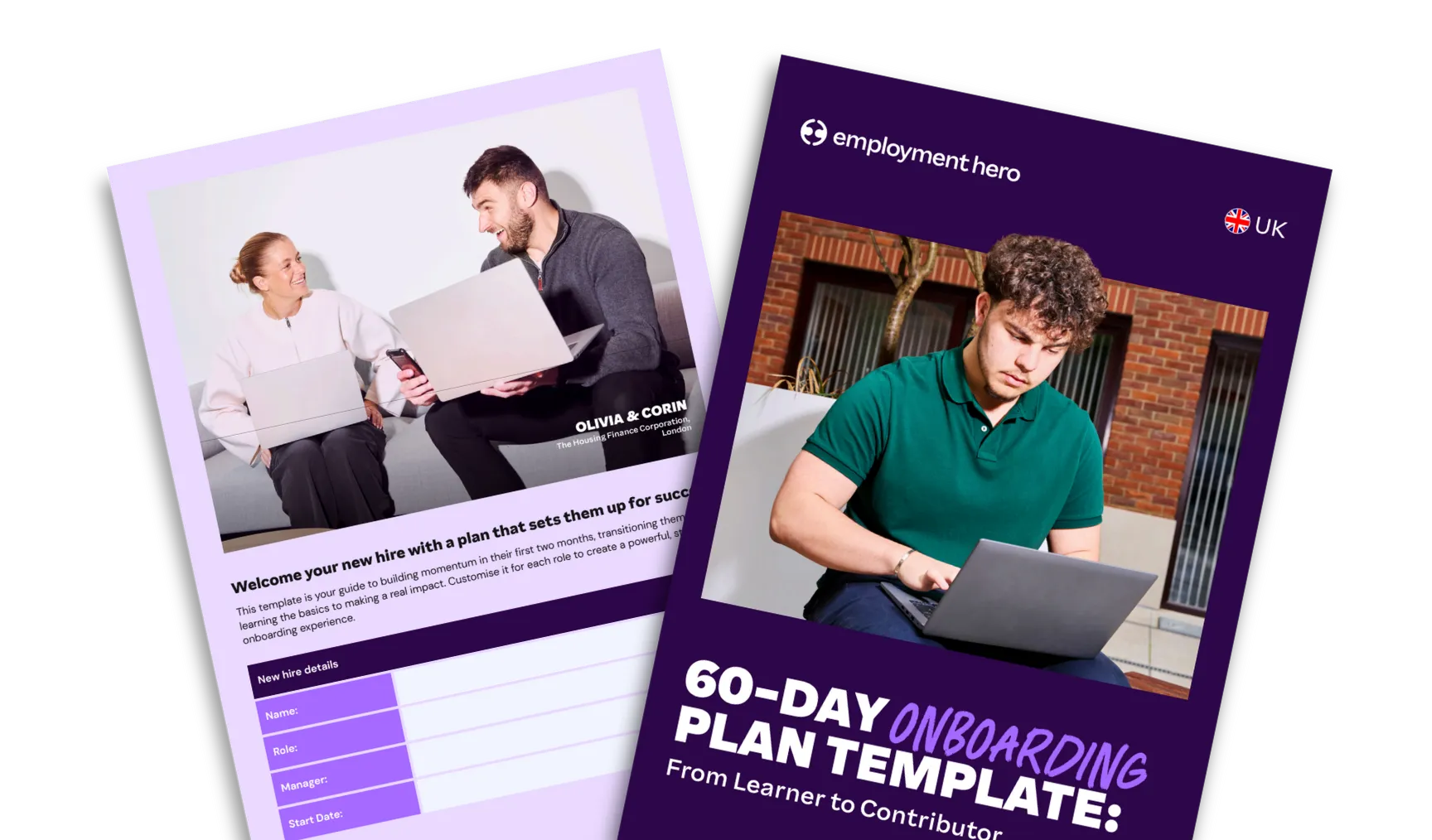Return to work interview template
Published
Return to work interview template
Published
Updated
2 min read
A return to work interview template is a great way to ease your employees back into work after a period of absence. While not mandatory, they provide a structured process that can help your team feel supported while transitioning back into their routine. And for business leaders and HR managers they help to streamline the process of getting someone back up to speed with work.
But if you, as a business leader or HR manager, are unsure where to start, our return to work interview template has you covered.
This return to work interview template makes it easier to support your team and stay compliant, so keep reading as we dive into how you can better manage employee absences with our handy return to work template.
What’s in this return to work interview template?
This template covers two elements of return to work meetings.
The first is a return to work form for employees to complete when they return, capturing essential information such as the reason for absence, duration, whether medical advice has been sought, and confirmation that they’re fit to resume work.
The second is a return to work interview template designed for managers to use during a conversation with the employee. It includes structured prompts to discuss the employee’s wellbeing, any adjustments needed, and any ongoing concerns.
Both forms can be saved as part of your HR records to ensure compliance and consistent support for returning employees.
Here’s a sneak peek of what the return to work interview template covers:
- What to note in relation to an employee’s absence record
- How to record reasons for absence
- How to structure a return to work plan
The information in this article is current as of May 2025, and has been prepared by Employment Hero Pty Ltd (ABN 11 160 047 709) and its related bodies corporate (Employment Hero). The views expressed in this article are for general information only, are provided in good faith to assist employers and their employees, and should not be relied on as professional advice. The information is based on data supplied by third parties. While such data is believed to be accurate, it has not been independently verified and no warranties are given that it is complete, accurate, up to date or fit for the purpose for which it is required. Employment Hero does not accept responsibility for any inaccuracy in such data and is not liable for any loss or damages arising either directly or indirectly as a result of reliance on, use of or inability to use any information provided in this article. You should undertake your own research and seek professional advice before making any decisions or relying on the information in this article.
What are return to work meetings?
Return-to-work meetings help ensure employees returning from illness or injury feel supported. Back to work interviews are held between an employer and an employee after an absence from work, typically due to illness or injury. The purpose is to discuss the employee’s return to work. And they can help to ensure that the transition is as smooth as possible and that any issues that may affect the employee’s ability to work are addressed.
These meetings serve a number of purposes.
1. Welcome the employee back to work
A back to work interview is an opportunity for you, as a business leader or HR professional to:
- Welcome your employee back to work
- Show support for their return
- Promote a wellbeing first culture that fosters a sense of morale and loyalty that could reduce the likelihood of unnecessary leave
2. Discuss the reason for the absence
In a return to work meeting, you may discuss the reason for absence, in order to better understand their situation and identify any issues that may have contributed to it.. This can provide business leaders and HR professionals with the clarity they need, highlighting any issues that could be resolved to prevent future absenteeism.
3. Review any necessary paperwork
When a team member has taken a leave of absence, there is often paperwork that needs to be filed. A return to work conversation is an opportunity to review any necessary paperwork, such as a doctor’s note or a return to work plan.
4. Address any concerns or adjustments
Once you, as an HR manager or business leader, understand the reasons for your team members/absence, you can use the back to work interview to address any concerns that your employee may have. You may also choose to discuss any reasonable adjustments that may be needed to help them return to work successfully, such as a reduced workload or flexible hours.
According to the Equality Act 2010, employers have a duty of care to make reasonable adjustments for employees with disabilities or physical and mental health issues.
Examples of adjustments for physical health conditions could include:
- Ergonomic assessments: This ensures that an employee’s workstation is tailored to their needs and includes adjustable chairs, desks and keyboard supports.
- Mobility aids: Wheelchairs or walking aids where required.
- Assistive tech: Screen magnifiers, speech recognition or other assistive resources come under this umbrella.
- Flexible hours: Allow for varied start and finish times, and adjust break times.
- Modified duties: Adapt job roles or reallocate physically demanding tasks.
Examples of adjustments for mental health conditions could include:
- Duvet days: A policy that allows employees to take time off when their mental health is suffering.
- Quiet spaces: Alternative workspaces allow employees to work away from loud noises or distractions.
- Support services: Access to counselling resources or employee assistance programs (EAPs) when required.
- Phased return to work after mental health leave: Gradual reintegration that can include reduced hours or lighter duties H3: 5. Set expectations
Finally, this is the appropriate setting in which you can set out expectations for your employee’s return to work, including performance expectations, work hours, and any ongoing support that you can provide. It’s the perfect time to remind them of the impact that absenteeism has on team dynamics and productivity and clarify attendance policies.
All of this is made simple with our return to work interview template.
Who should attend return to work interviews?
Who joins a return to work interview can vary depending on your company’s policies, but generally, you can expect a few key people to be involved.
Here’s who’s usually in the room.
The employee
The employee who has been absent from work due to illness or injury is the most crucial person who attends the return to work interview. The meeting is an opportunity for the employee to discuss their absence and return to work.
The employee’s line manager or supervisor
The employee’s line manager or supervisor should attend the meeting to discuss any work-related issues that may have contributed to the employee’s absence and to help plan the way ahead.
An HR representative
Where possible, an HR representative should attend the meeting to ensure that the company’s policies and procedures are followed and to provide support to both the employee and line manager or supervisor.
Occupational health provider or medical professional
Depending on the nature and duration of the employee’s absence, an occupational health provider or a medical professional may be present in the meeting to provide additional medical information, as well as helping to plan the employee’s return to work.
What are some reasons for prolonged absence from work?
Your employees are the driving force of your company, and a happy, healthy workforce means a happy, healthy and successful company. Absences can happen for any number of reasons, but it’s important for a business to keep an eye on staff absences, especially prolonged absences, because it’s a warning sign of absenteeism—the practice of regularly missing work without good reason.
When it comes to prolonged absence from work, there are some common reasons:
- Illness or injury
- Acute medical conditions
- Mental health issues such as stress, anxiety or depression
- Bereavement
- Family reasons, such as caring for a child or an elderly or sick relative
Of these, stress often tops the list. In 2023 in the UK, 57% of organisations reported that one of the most common reasons for long-term absences was for mental health issues.
In any event, it’s essential to treat each case of prolonged absence from work with sensitivity and empathy. Employers should follow their company’s policies and procedures for managing absence, which may include offering support to the employee, monitoring the absence, and planning the employee’s return to work. This can all help your employee feel heard and feel valued.
How to run an effective return to work interview
When an employee returns to work, it’s a good idea to schedule a return to work interview. This is where our handy return to work template comes in.
And if you’re wondering how to approach it, here are our top tips for running an effective return to work interview.
1. Preparation is key
Determine who will attend the interview, and prepare and circulate an agenda. Review the employee’s attendance records, job description, and any relevant medical information before the meeting. This preparation will help you understand the reason for the employee’s absence and facilitate a more productive discussion.
2. Create a supportive environment
How you create a supportive environment depends on where you and your team work. For teams that come into the office a conversation should be conducted in a private and supportive environment. If you have a remote team, it’s more about organising a suitable time for both parties to join a video call.
Regardless of if your employee works in the office or from home, it’s important to set a tone that makes them feel comfortable, and confident enough to share their experience.
3. Start with an open-ended question
Start the interview with an open-ended question to allow the employee to share their experience. For example, “Can you tell me how you are feeling about returning to work?” This will help you to understand the employee’s perspective.
4. Listen actively
Active listening is essential during the interview. Listen carefully to the employee’s responses, including non-verbal cues, and show empathy and understanding. Don’t interrupt, but don’t be afraid to take notes and ask clarifying questions to make sure you understand what your employee is telling you.
5. Identify any work-related issues
Identify any work-related issues that may have contributed to the employee’s absence. For example, workload, stress, or relationship issues. This will help you address any underlying problems and prevent further absence.
6. Discuss support
Discuss the support available to the employee, such as employee assistance programmes (EAP), counselling services, occupational health services, or further training. Depending on the reasons for absence, you might also want to consider how you can improve your employee experience, and share any relevant resources with your employee and wider team.
7. Agree on a return-to-work plan
Agree on a return to work plan that outlines the employee’s duties, responsibilities, and work schedule, taking into account the employee’s needs and medical advice. It may be appropriate to discuss performance evaluations and to set goals and objectives. It is crucial to discuss how attendance will be monitored and the consequences of not meeting attendance requirements. Frame these clearly but supportively, indicating that the goal is to help the employee succeed.
Importantly, the plan should include any necessary accommodations or reasonable adjustments to support the employee’s return to work. Explain that the plan is a working document and that it should remain flexible and reviewed regularly.
8. Follow up
After the return to work interview is over, you’ll want to check in on your employee. Here’s a guideline on when and how to do that.
When to check in:
- Typically you should wait a few days after the interview before you check in to give the employee time to process what was discussed.
- After this initial check in, follow up with the employee regularly to ensure they are coping well and to make any necessary adjustments to the return to work plan.
How to check in:
- Email is usually the simplest and least intrusive approach. A clear subject line and a polite message to remind employees that your door is always open should be sufficient.
- One-to-one meetings are a great way to keep in contact with your employees.
Whatever cadence you decide to follow, make sure you set a date to follow up on any action items and to review the return to work plan.
Don’t forget to follow our best practice tips to ensure compliance when recording notes during the interview.
- Use a standard format (our template ticks this box)
- Record only objective information and observations. Leave out personal opinions.
- Capture the key points: Use bullet points for clarity.
- Clearly outline action items: Note who is responsible for each action and include any deadlines.
- Document attendance: Make a note of who attended the interview.
- Store the notes securely: Confidential information must be protected, so be sure to store the data securely.
Examples of return to work interview questions
Need some more guidance on what to say to your employee? Here are some examples of return-to-work interview questions that can be used to guide the discussion with your employee:
- Can you tell me more about your absence and what led to it?
- How are you feeling now? Have you fully recovered or are there any ongoing health issues we should be aware of?
- Are there any adjustments or accommodations that we can make to support your return to work?
- How did you find the process of reporting your absence and staying in touch with the company during your time away?
- Were there any work-related issues that contributed to your absence? If so, how can we address them to prevent future absences?
- Do you have any concerns or questions about returning to work?
- What do you feel would be the best way for us to support you in your return to work?
- Is there anything else you would like to discuss or any feedback you would like to provide?
Just remember to tailor the questions to the specific circumstances of the employee and their absence.
What if an employee refuses to attend a return to work interview?
If an employee refuses to attend a return-to-work interview or refuses to disclose information during it, it’s important to understand the reasons for their reluctance and try to address any concerns they may have. Start by reminding the employee of their obligation to attend the meeting and the importance of the meeting in ensuring a successful return to work.
Some employees may be uncomfortable discussing personal health issues or may be concerned about disclosing sensitive information, so be prepared for difficult conversations. In these cases, it may be helpful to reassure the employee that the meeting will be conducted in a confidential and supportive manner and that any information shared will be used solely for the purpose of supporting their return to work. Always approach these conversations with empathy and understanding.
If the employee is refusing to attend the meeting for more substantive reasons, such as a dispute with their manager or dissatisfaction with the company’s policies, it may be necessary to address these concerns separately. It may be helpful to involve a neutral third party, such as an HR representative or a mediator, to help facilitate the discussion and find a mutually acceptable resolution.
Ultimately, if an employee continues to refuse to attend the return to work interview without a valid reason, you may need to take further action in accordance with your disciplinary policies and procedures. However, this should be seen as a last resort, and every effort should be made to address the employee’s concerns and ensure a successful return to work.
Download the return to work interview template now
Managing absences effectively goes a long way towards cultivating a strong company culture which is likely to engage employees and reduce turnover. But on top of all the other tasks business owners and HR professionals have on their plates, it can be hard to keep up. This is where Employment Hero can help.
Employment Hero’s Employment Operating System (OS) takes the traditional isolated aspects of employment and integrates them into a seamless, human and AI-powered solution that empowers employers, employees and job seekers alike.
Find and hire top talent with SmartMatch, seamlessly onboard new hires, automate complex payroll, drive employee engagement and more!
Our all-in-one system puts HR, payroll, hiring and more all in one place.
Register for the Template.
Related Resources
-
 Read more: Predictive Modelling in HR: Stop Guessing, Start Winning
Read more: Predictive Modelling in HR: Stop Guessing, Start WinningPredictive Modelling in HR: Stop Guessing, Start Winning
Discover how predictive modelling in HR can transform decision-making. Learn about key models, algorithms and steps to implement predictive analytics.
-
 Read more: Team Cohesion: The Ultimate Toolkit For Cross-Functional Collaboration
Read more: Team Cohesion: The Ultimate Toolkit For Cross-Functional CollaborationTeam Cohesion: The Ultimate Toolkit For Cross-Functional Collaboration
Learn how to build team cohesion and improve cross-functional collaboration. Discover actionable strategies, team-building activities and key behaviours.
-
 Read more: Your 60 day onboarding plan: The free template for building momentum
Read more: Your 60 day onboarding plan: The free template for building momentumYour 60 day onboarding plan: The free template for building momentum
Download a free 60 day onboarding plan template. Learn how to set clear goals, track progress and ensure new hire…



















